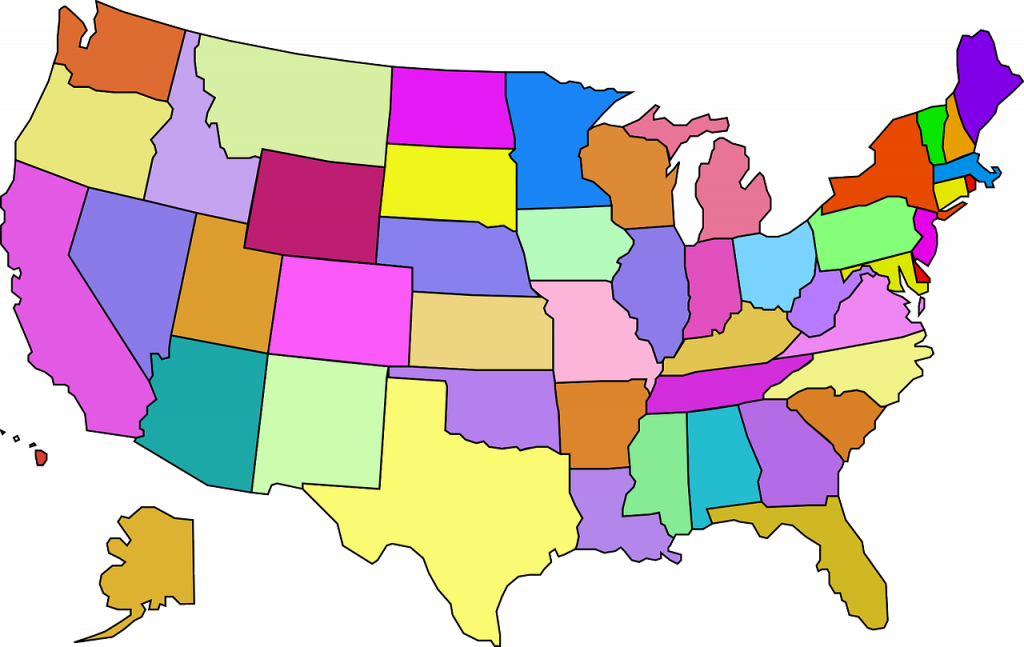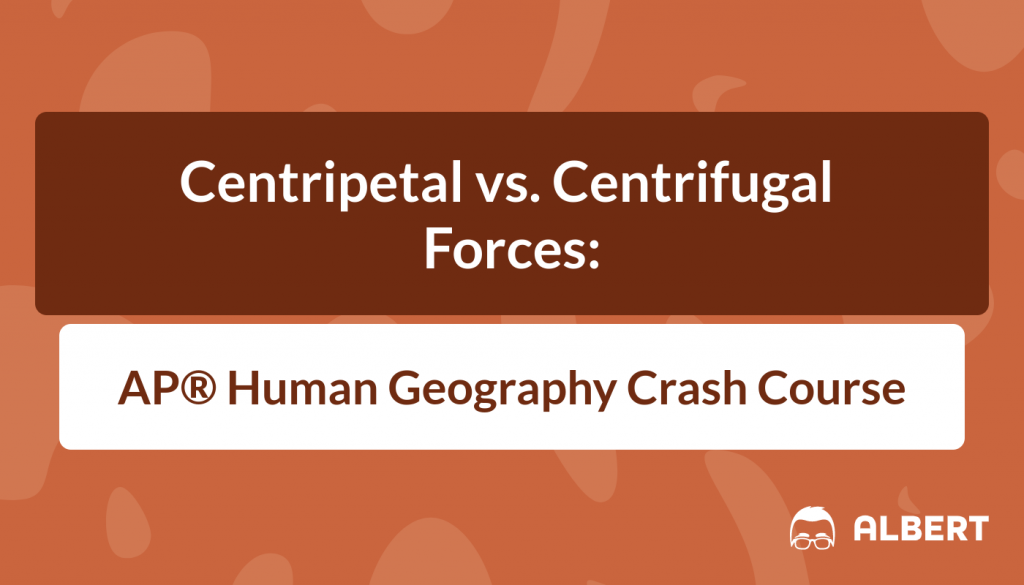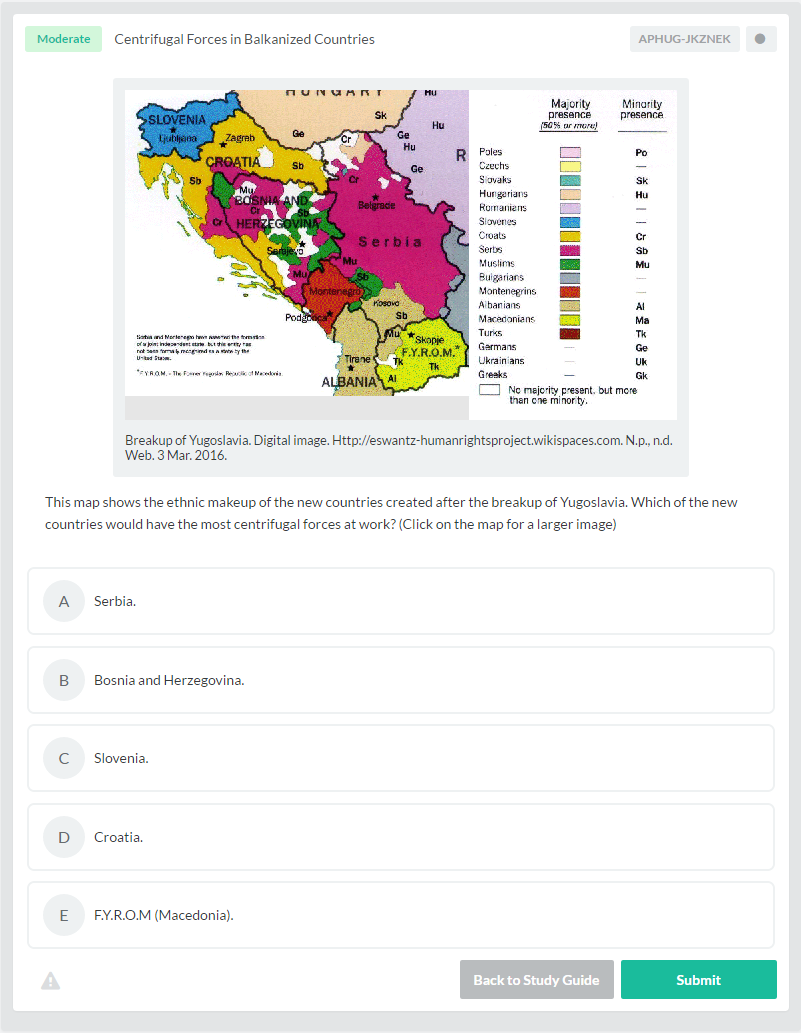Countries today face a myriad of issues that threaten to divide its citizens. Religious differences, for example, can split people of the same culture. Differences in language can be a cause for unrest, and may require resolution by the central government. Cultural diversity in many countries is deeply rooted and can create powerful divisions within the population. Divisions are a reality in any country, but there are also forces that unite countries and strengthen the populace because of a strong love of and loyalty to their country. This AP® Human Geography study guide will explore those forces that divide (centrifugal) or unify (centripetal) a country. We will define centrifugal and centripetal forces and how they can originate in political, economic or cultural dimensions. We will also discuss why these two forces are vital to the survival of the state.
Both centrifugal and centripetal forces exist in the same dimensions, and examples are in the areas of religion, language, ethnicity, government, and physical geography. This study guide will help you understand the definition centrifugal and centripetal forces and give you examples of how each force can unite or divide a state.
What Makes a State a State?

The concepts of political geography and the state are important to understand when we discuss centripetal and centrifugal forces, because they may affect the future of a country. In the context of human geography, please note that term terms state and country are synonymous and are used interchangeably. Before we look at forces that can divide or unite a country, let’s review the concepts of political geography and the state. Political geography is how humans define and control land and its resources through the establishment of states. Our planet is divided into political units called states or countries. Each country has defined borders, which have set boundaries, and are organized into a political unit, ruled by an established government that has control over its internal and foreign affairs. Countries occupy a defined territory and have a permanent population. A state has sovereignty, which means independence from control of its internal affairs by other states. A nation is a group of unified people with a common culture. The Kurds would be an example of a nation without a state of their own. Nation-states describe a state comprised of a population with over 90 percent of a particular culture. Japan and Lesotho are good examples of nation-states.
A concern of any country is how to stay sovereign in the face of forces that may divide its citizens. States draw on unifying forces to rally its citizens behind forces common to its national identity. A federal state gives local political units like states or provinces within that country a measure of power. Conversely, unitary states are characterized by a strong central government. Divisive forces threaten a country’s sovereignty by dividing the country and breaking down the central government. They are also forces that unite and bind a country together like a common faith or a shared ideology. Let’s look at what those forces are.
Centripetal vs Centrifugal Forces Defined
The theory of centripetal and centrifugal forces is associated with political geographer Richard Hartshorne. He argued that the integration of a state’s geographical area involved two competing forces. Centrifugal forces that pull people apart, and centripetal forces that bring people together. These forces can limit interaction, producing regionalism and creating dissimilarity among people of a country. So, what stops a country from falling apart? That country must have centripetal forces of greater magnitude than the centrifugal forces. Countries are susceptible to forces that divide or unite them. Centripetal forces unite a country where centrifugal forces tend to divide. When the centripetal forces dominate a country, it will stand firm in the face of global challenges and struggles, as well as conflicts within their borders. When internal centrifugal forces threaten to divide the country, the central government may break down and fail. A strong and charismatic leader can mitigate this division. National institutions and symbols can also rally a country together in spite of division. Nationalism, or the strong love of and loyalty to one’s country, is also a powerful centripetal force and can create solidarity among the populace.
What are Some Examples of Centripetal Forces?
We know that centripetal force is an attitude that unifies people and enhances support for a state. In other words, centripetal forces from within a state unite it and keep the country together. They stabilize and strengthen the country and create a sense of unity. Let’s look at examples of centripetal forces and why they are important to the state.
National identity is a strong centripetal force in the political dimension. A popular way of showing national identity is through the use of icons and expressions, depicted in flags, national anthems, and sports teams. These symbols reinforce a national awareness and instill in the population a sense of pride and loyalty. An example of a centripetal force would be during the 1995 Rugby World Cup. Then president of South Africa, Nelson Mandela used the Springboks, the national rugby team, to help unite a divided nation. South Africa had just broken free from more than 400 years of racial inequality.
Centripetal forces in the economic dimension unite a country by ensuring the population that there are sufficient resources to support the long-term stability of the state. A first-class infrastructure would be a centripetal force in a state. When there is a good transportation system that is available to all citizens, all the resources of the country are accessible, making life easier for the everyone. The excellent railroad system in India is an example of a centripetal force in the economic dimension.
Centripetal forces in the cultural realm can be the most powerful unifying force all. Religion and language are tied closely with culture and emote strong, sometimes overpowering feelings of unity and are examples centripetal forces within in a state. Hinduism in Nepal and India brings people together as they feel a sense of unity. In Israel, Modern Hebrew was created to unify a wave of global immigrants looking for a new life in the Jewish homeland.
What are Some Examples of Centrifugal Forces?
Centrifugal forces, in contrast to centripetal forces, are forces or attitudes that tend to divide a state. Centrifugal forces originate in the same dimensions as centripetal forces, but the forces pull the population apart instead of bringing it together. Centrifugal forces can also include physical features that limit interaction between the people of the state. Human-made concepts like differences in religious beliefs, culture, and economic activity also act as centrifugal forces. As we learned, to survive, there must be centripetal forces of greater than the centrifugal force in a state. If these centrifugal forces reach a critical stage, it can lead to Balkanization, which is the process where a state breaks down through struggles among ethnic groups. Centrifugal forces alter and weaken a state by disrupting the internal order of the country.
Political forces can divide a country when its citizens do not trust the central government, disagree with its political ideology, or when minority groups are mistreated or underrepresented. This centrifugal force can lead to poor relationships between the majority and minority groups and even to armed conflict or civil war.
Centrifugal forces in the cultural dimension can be just as divisive as centripetal forces are unifying. Cultural diversity in many states creates powerful divisions among the people. Religious differences can be an overriding centrifugal force in a country. These divisions can lead to separatist movements like the Sikhs in India or the Kurds in Turkey. Another example is the ideological differences between the Shiite and Sunni Muslims, acting as a centrifugal force because their differences in ideology are polarizing rather than unifying. Language can also pull apart a nation as is the case in India where there are more than a dozen official languages. Poor communication can lead to misunderstanding and conflict.
Economic centrifugal forces can create feelings of inequality in a state. Poor regions of a country can feel disadvantaged by wealthier ones. Richer areas of the country can also feel put upon by having to provide subsidies to poorer ones. In Italy, the richer north pushed for autonomy from the poorer south. Despite subsidies, the development gap is growing. In Brazil, wealthier provinces of the south argue that tax money is being misspent by the government for assistance to the Amazon Forest region.
Centripetal and Centrifugal Forces and the AP® Human Geography Exam

The CollegeBoard places significance on centripetal and centrifugal forces when it comes to the AP® Human Geography exam. The course description even dedicates a learning objective to these forces. You need to make sure you understand the differences between centrifugal and centripetal forces and how they can unite and divide a country’s population. Be sure you have a thorough understanding of both forces and can give examples and specific details based on the three dimensions of centrifugal and centripetal forces: political, cultural and economic.
You can expect a FRQ on this topic since it has been part of past AP® Human Geography exams. Here is an example from the 2006 FRQ (question 3)
3. The viability of any state depends on a balance between centripetal and centrifugal forces.
- Define the concepts “centripetal force” and “centrifugal force.”
- Give a specific example of and explain a centripetal force that affects the viability of any of the states shown on the map above.
- With reference to a different specific example, explain a centrifugal force that affects the viability of any of the states shown on the map above.
For Part A of the question, make sure you reference the viability of the state in each definition. For example, centrifugal forces divide a state and can lead to a disruption of internal order or balkanization. Centripetal forces unify a state by providing stability and creating solidarity.
For Parts B and C, make sure you give specific details for each example. If you chose religion as a centripetal force, you might talk about Hinduism in India or Nepal, Islam in Pakistan or Bangladesh, or Buddhism in Bhutan. If you use cultural difference or separatist movements as a centrifugal force, you can discuss the Sikhs in India, the Muslims in Kashmir, or the Maoist rebels in Nepal.
Make sure you do not use the same force and country for both B and C. You may use the same country with different forces, or the same force with different countries.
Conclusion
We have learned that divisive forces are a reality in our world, but that there are also forces that unite countries and strengthen the state. Those forces that divide are centrifugal, and those that unify are called centripetal. We know that both types of forces can originate in the political, economic or cultural dimensions and are vital to the survival of the state. Examples of centrifugal and centripetal force are found in religion, language, ethnic culture, government, and physical geography. Hopefully, this AP® Human Geography study guide has helped you understand this concept more clearly so you can apply what you have learned when you take the AP® Human Geography Exam.
Let’s put everything into practice. Try this AP® Human Geography practice question:
Looking for more AP® Human Geography practice?
Check out our other articles on AP Human Geography.
You can also find thousands of practice questions on Albert.io. Albert.io lets you customize your learning experience to target practice where you need the most help. We’ll give you challenging practice questions to help you achieve mastery in AP® Human Geography.
Start practicing here.
Are you a teacher or administrator interested in boosting AP® Human Geography student outcomes?
Learn more about our school licenses here.









